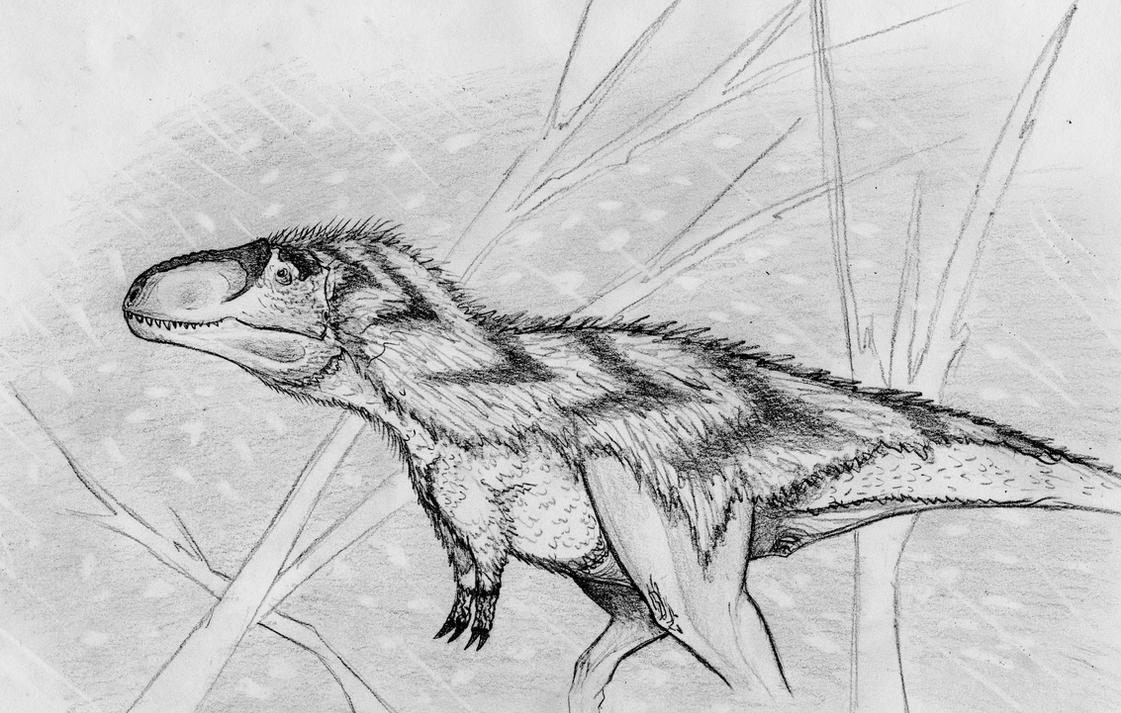Post by thesporerex on Mar 13, 2014 2:44:16 GMT
Nanuqsaurus hoglundi

Scientific classification:
Kingdom: Animalia
Phylum: Chordata
Clade: Dinosauria
Clade: Theropoda
Superorder: Tyrannosauriodae
Order: Tyrannosauridae
Suborder: Tyrannosaurinae
Genus: Nanuqsaurus
Species: Nanuqsaurus hoglundi

Scientific classification:
Kingdom: Animalia
Phylum: Chordata
Clade: Dinosauria
Clade: Theropoda
Superorder: Tyrannosauriodae
Order: Tyrannosauridae
Suborder: Tyrannosaurinae
Genus: Nanuqsaurus
Species: Nanuqsaurus hoglundi
Fossil range: Late Cretaceous Maastrichtian, 69 million years ago
Length: ~5-6 metres
Weight: ~?500kg
Height: (unpublished)
Location: Alaska USA
Skull length: ~600m-700mm
Name meaning: "polar bear lizard"
Description:
Nanuqsaurus (meaning "polar bear lizard") is an extinct genus of carnivorous tyrannosaurid theropod dinosaur known from the Late Cretaceous (early Late Maastrichtian stage) Prince Creek Formation of the North Slope of Alaska. Nanuqsaurus was first described and named by Anthony R. Fiorillo and Ronald S. Tykoski in 2014 and the type species is Nanuqsaurus hoglundi. Nanuqsaurus was a very small Tyrannosaur comparable to that of the Alaskan Troodon but it was even more closely related to Tyrannosaurus than its predecessor Lythronax and Daspletosaurus.

In 2006, at the Kikak-Tegoseak Quarry, in North Slope Borough in the north of Alaska, fossils were found of a medium-sized theropod, with an estimated skull length of 600–700 mm (24–28 in). These were first referred to Gorgosaurus and later to Albertosaurus. After preparation in the Perot Museum of Nature and Science (Dallas Museum of Natural History) it was recognised these represented a species new to science. Nanuqsaurus was first described and named by Anthony R. Fiorillo and Ronald S. Tykoski in 2014. The type species is Nanuqsaurus hoglundi. The generic name is derived from Iñupiaq nanuq, "polar bear". The specific name honours the philanthropist Forrest Hoglund. The holotype, DMNH 21461, has been found in a layer of the Prince Creek Formation, dated at 69.1 million years. It consists of a partial skull with a lower jaw. It contains the nasal branch of the right maxilla; a partial skull roof including partial parietals, frontals and a right laterosphenoid; and the front of the left dentary.

Nanuqsaurus hoglundi's holotype fossils
Papers:
1. A Diminutive New Tyrannosaur from the Top of the World(Original paper)
Abstract: "Tyrannosaurid theropods were dominant terrestrial predators in Asia and western North America during the last of the Cretaceous. The known diversity of the group has dramatically increased in recent years with new finds, but overall understanding of tyrannosaurid ecology and evolution is based almost entirely on fossils from latitudes at or below southern Canada and central Asia. Remains of a new, relatively small tyrannosaurine were recovered from the earliest Late Maastrichtian (70-69Ma) of the Prince Creek Formation on Alaska's North Slope. Cladistic analyses show the material represents a new tyrannosaurine species closely related to the highly derived Tarbosaurus+Tyrannosaurus clade. The new taxon inhabited a seasonally extreme high-latitude continental environment on the northernmost edge of Cretaceous North America. The discovery of the new form provides new insights into tyrannosaurid adaptability, and evolution in an ancient greenhouse Arctic."
Paper: www.plosone.org/article/info%3Adoi%2F10.1371%2Fjournal.pone.0091287
Length: ~5-6 metres
Weight: ~?500kg
Height: (unpublished)
Location: Alaska USA
Skull length: ~600m-700mm
Name meaning: "polar bear lizard"
Description:
Nanuqsaurus (meaning "polar bear lizard") is an extinct genus of carnivorous tyrannosaurid theropod dinosaur known from the Late Cretaceous (early Late Maastrichtian stage) Prince Creek Formation of the North Slope of Alaska. Nanuqsaurus was first described and named by Anthony R. Fiorillo and Ronald S. Tykoski in 2014 and the type species is Nanuqsaurus hoglundi. Nanuqsaurus was a very small Tyrannosaur comparable to that of the Alaskan Troodon but it was even more closely related to Tyrannosaurus than its predecessor Lythronax and Daspletosaurus.
Silhouettes showing approximate sizes of representative theropods. A, Nanuqsaurus hoglundi, based on holotype, DMNH 21461. B, Tyrannosaurus rex, based on FMNH PR2081. C, Tyrannosaurus rex, based on AMNH 5027. D, Daspletosaurus torosus, based on FMNH PR308; E, Albertosaurus sarcophagus, based on TMP 81.10.1; F, Troodon formosus, lower latitude individual based on multiple sources and size estimates; G, Troodon sp., North Slope individual based on extrapolation from measurements of multiple dental specimens
Discovery:In 2006, at the Kikak-Tegoseak Quarry, in North Slope Borough in the north of Alaska, fossils were found of a medium-sized theropod, with an estimated skull length of 600–700 mm (24–28 in). These were first referred to Gorgosaurus and later to Albertosaurus. After preparation in the Perot Museum of Nature and Science (Dallas Museum of Natural History) it was recognised these represented a species new to science. Nanuqsaurus was first described and named by Anthony R. Fiorillo and Ronald S. Tykoski in 2014. The type species is Nanuqsaurus hoglundi. The generic name is derived from Iñupiaq nanuq, "polar bear". The specific name honours the philanthropist Forrest Hoglund. The holotype, DMNH 21461, has been found in a layer of the Prince Creek Formation, dated at 69.1 million years. It consists of a partial skull with a lower jaw. It contains the nasal branch of the right maxilla; a partial skull roof including partial parietals, frontals and a right laterosphenoid; and the front of the left dentary.

Nanuqsaurus hoglundi's holotype fossils
Paleobiology:
According to paleontologists, about 70 million years ago northern Alaska was apart of an ancient subcontinent called Laramidia and experienced cold weather and long periods of darkness and light, in addition to seasons in which food was not readily available. Prey availability likely would have increased suddenly during the summer, but then declined in the dark winter, leaving predators with little to eat.
Fiorillo in his study, which appeared on 12 March 2014 in the journal PloS ONE, stated that this lack of food might explain Nanuqsaurus hoglundi's unusually small size, as a large animal cannot survive on scarce resources. The shape of its skull suggested it had an inflated area of its brain devoted to smell, which suggests the animal relied heavily on scent to hunt its prey, like Tyrannosaurus rex.
It is likely, due to size and its cool environment, that Nanuqsaurus hoglundi was covered in a fuzzy mass of feathers, like some other tyrannosaurs.

According to paleontologists, about 70 million years ago northern Alaska was apart of an ancient subcontinent called Laramidia and experienced cold weather and long periods of darkness and light, in addition to seasons in which food was not readily available. Prey availability likely would have increased suddenly during the summer, but then declined in the dark winter, leaving predators with little to eat.
Fiorillo in his study, which appeared on 12 March 2014 in the journal PloS ONE, stated that this lack of food might explain Nanuqsaurus hoglundi's unusually small size, as a large animal cannot survive on scarce resources. The shape of its skull suggested it had an inflated area of its brain devoted to smell, which suggests the animal relied heavily on scent to hunt its prey, like Tyrannosaurus rex.
It is likely, due to size and its cool environment, that Nanuqsaurus hoglundi was covered in a fuzzy mass of feathers, like some other tyrannosaurs.

1. A Diminutive New Tyrannosaur from the Top of the World(Original paper)
Abstract: "Tyrannosaurid theropods were dominant terrestrial predators in Asia and western North America during the last of the Cretaceous. The known diversity of the group has dramatically increased in recent years with new finds, but overall understanding of tyrannosaurid ecology and evolution is based almost entirely on fossils from latitudes at or below southern Canada and central Asia. Remains of a new, relatively small tyrannosaurine were recovered from the earliest Late Maastrichtian (70-69Ma) of the Prince Creek Formation on Alaska's North Slope. Cladistic analyses show the material represents a new tyrannosaurine species closely related to the highly derived Tarbosaurus+Tyrannosaurus clade. The new taxon inhabited a seasonally extreme high-latitude continental environment on the northernmost edge of Cretaceous North America. The discovery of the new form provides new insights into tyrannosaurid adaptability, and evolution in an ancient greenhouse Arctic."
Paper: www.plosone.org/article/info%3Adoi%2F10.1371%2Fjournal.pone.0091287







 <- imma rek u btichs
<- imma rek u btichs